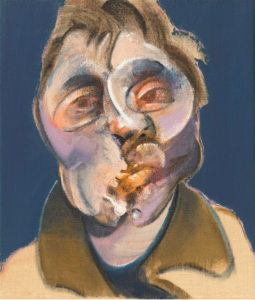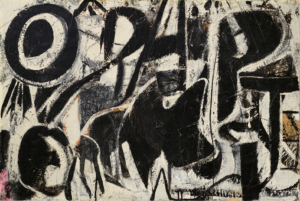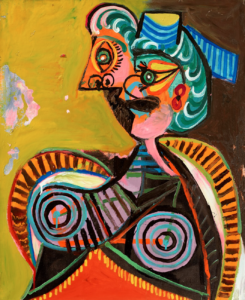
Self-Portrait by Francis Bacon
On Thursday, May 11th, Christie’s New York held some of the biggest sales so far this year. Before they could start their 20th Century evening sale, they first offered the works from the S.I. Newhouse collection. Samuel Irving Newhouse, Jr. was a media magnate who co-owned Advance Publications, the parent company of magazines such as Bon Appétit, GQ, The New Yorker, Vanity Fair, and Vogue. This sale consisted of sixteen paintings by many of the great masters of the twentieth century. Though not expected to be the top lot, a self-portrait by Francis Bacon became the sale’s star. Created around 1969, it’s a small work, only 14 by 12 inches, but it is incredibly striking and typical of Bacon’s beautifully grotesque style. It was previously in the collection of Bacon’s friend and dealer Valerie Beston, and it last sold at Christie’s London for a hammer of £4.6M. Bacon’s self-portrait surpassed its $28M high estimate, with the hammer coming down at $29.75M (or $34.6M w/p).

Orestes by Willem de Kooning
Behind the Bacon portrait was the sale’s final lot, Willem de Kooning’s Orestes. This is a work from early in De Kooning’s career as a purely abstract painter, experimenting with a series of black-and-white works throughout the late 1940s. It was part of De Kooning’s first-ever solo show at the Egan Gallery in New York in 1948. Orestes was last sold at auction at Sotheby’s New York in 2002 for $12M hammer, and was included in the popular 2011-12 retrospective at New York’s Museum of Modern Art. Sotheby’s specialists estimated it would sell in excess of $25M, and it ended up selling for $26.5M (or $30.89M w/p). Finally, Sotheby’s experts originally predicted that Picasso’s abstract portrait L’Arlésienne would be the sale’s top lot, assigning it a $20M to $30M estimate range. The subject is Lee Miller, a photojournalist who, only a few years after Picasso created this portrait, served as a Vogue correspondent in Europe for much of the Second World War. The title, referring to a woman from Arles, refers to Miller’s first encounter with Picasso, since they first met while both on vacation on the French Riviera. Picasso would create six other portraits of Miller in 1937, but the one offered at Christie’s on Thursday is one of the only ones the artist kept for himself. L’Arlésienne eventually sold for $21M (or $24.56M w/p) against an estimate range of $20M to $30M.

L’Arlésienne by Pablo Picasso
There are often not many surprises in a sale with so few lots, and with those lots having very high estimates. However, one work sold for exactly double its $1.5M high estimate. After Chardin by Lucian Freud was created in 1999, and serves as a sort of homage to one of Western painting’s great masters. The work is Freud’s version of The Young Schoolmistress by the eighteenth-century French still-life master Jean Siméon Chardin. This is not unusual for Freud, recreating older works while adding a few of his own personal stylistic touches. Throughout his career, Freud created his own versions of Jean-Antoine Watteau and John Constable’s works. After Chardin eventually sold for $3M (or $3.8M w/p). But while I normally write about surprises in terms of pieces that sold for much higher amounts than expected, there was a surprise of the opposite kind. Roy Lichtenstein is best known for “appropriating” the works of twentieth-century comic and commercial artists. However, some of his works also reach as far back as the impressionists. I didn’t think much of it when I saw Rouen Cathedral through my laptop’s screen. But it grew on me when I visited Christie’s and viewed the work in person. It’s a triptych made with oil paint and acrylic resin on canvas, each segment measuring 63 by 42 inches. The images can only be seen from a distance, with the individual dots of paint creating a clear image of the front door of Rouen Cathedral. I recognized the image almost instantly because it is based on the over thirty paintings Claude Monet created of the cathedral in 1892 and 1893. The Lichtenstein version became one of my favorite lots in the sale, but unfortunately sold far under its estimate. Christie’s specialists assigned a $18M to $22M range, but there was insufficient interest on Thursday evening. The hammer came down only at $13M (or $15.36M w/p), about 28% below what was expected.
The Newhouse Collection sale was an incredible prelude to the equally incredible 20th Century sale. Four of the sixteen lots sold within their estimates, giving Christie’s specialists a 25% accuracy rate. Another six lots (38%) sold below estimate, while six sold above. No lots went unsold. Estimated to bring in no less than $140.6M, the sixteen lots offered brought in a total of $150.4M.
Christie’s Newhouse Collection
Self-Portrait by Francis Bacon
On Thursday, May 11th, Christie’s New York held some of the biggest sales so far this year. Before they could start their 20th Century evening sale, they first offered the works from the S.I. Newhouse collection. Samuel Irving Newhouse, Jr. was a media magnate who co-owned Advance Publications, the parent company of magazines such as Bon Appétit, GQ, The New Yorker, Vanity Fair, and Vogue. This sale consisted of sixteen paintings by many of the great masters of the twentieth century. Though not expected to be the top lot, a self-portrait by Francis Bacon became the sale’s star. Created around 1969, it’s a small work, only 14 by 12 inches, but it is incredibly striking and typical of Bacon’s beautifully grotesque style. It was previously in the collection of Bacon’s friend and dealer Valerie Beston, and it last sold at Christie’s London for a hammer of £4.6M. Bacon’s self-portrait surpassed its $28M high estimate, with the hammer coming down at $29.75M (or $34.6M w/p).
Orestes by Willem de Kooning
Behind the Bacon portrait was the sale’s final lot, Willem de Kooning’s Orestes. This is a work from early in De Kooning’s career as a purely abstract painter, experimenting with a series of black-and-white works throughout the late 1940s. It was part of De Kooning’s first-ever solo show at the Egan Gallery in New York in 1948. Orestes was last sold at auction at Sotheby’s New York in 2002 for $12M hammer, and was included in the popular 2011-12 retrospective at New York’s Museum of Modern Art. Sotheby’s specialists estimated it would sell in excess of $25M, and it ended up selling for $26.5M (or $30.89M w/p). Finally, Sotheby’s experts originally predicted that Picasso’s abstract portrait L’Arlésienne would be the sale’s top lot, assigning it a $20M to $30M estimate range. The subject is Lee Miller, a photojournalist who, only a few years after Picasso created this portrait, served as a Vogue correspondent in Europe for much of the Second World War. The title, referring to a woman from Arles, refers to Miller’s first encounter with Picasso, since they first met while both on vacation on the French Riviera. Picasso would create six other portraits of Miller in 1937, but the one offered at Christie’s on Thursday is one of the only ones the artist kept for himself. L’Arlésienne eventually sold for $21M (or $24.56M w/p) against an estimate range of $20M to $30M.
L’Arlésienne by Pablo Picasso
There are often not many surprises in a sale with so few lots, and with those lots having very high estimates. However, one work sold for exactly double its $1.5M high estimate. After Chardin by Lucian Freud was created in 1999, and serves as a sort of homage to one of Western painting’s great masters. The work is Freud’s version of The Young Schoolmistress by the eighteenth-century French still-life master Jean Siméon Chardin. This is not unusual for Freud, recreating older works while adding a few of his own personal stylistic touches. Throughout his career, Freud created his own versions of Jean-Antoine Watteau and John Constable’s works. After Chardin eventually sold for $3M (or $3.8M w/p). But while I normally write about surprises in terms of pieces that sold for much higher amounts than expected, there was a surprise of the opposite kind. Roy Lichtenstein is best known for “appropriating” the works of twentieth-century comic and commercial artists. However, some of his works also reach as far back as the impressionists. I didn’t think much of it when I saw Rouen Cathedral through my laptop’s screen. But it grew on me when I visited Christie’s and viewed the work in person. It’s a triptych made with oil paint and acrylic resin on canvas, each segment measuring 63 by 42 inches. The images can only be seen from a distance, with the individual dots of paint creating a clear image of the front door of Rouen Cathedral. I recognized the image almost instantly because it is based on the over thirty paintings Claude Monet created of the cathedral in 1892 and 1893. The Lichtenstein version became one of my favorite lots in the sale, but unfortunately sold far under its estimate. Christie’s specialists assigned a $18M to $22M range, but there was insufficient interest on Thursday evening. The hammer came down only at $13M (or $15.36M w/p), about 28% below what was expected.
The Newhouse Collection sale was an incredible prelude to the equally incredible 20th Century sale. Four of the sixteen lots sold within their estimates, giving Christie’s specialists a 25% accuracy rate. Another six lots (38%) sold below estimate, while six sold above. No lots went unsold. Estimated to bring in no less than $140.6M, the sixteen lots offered brought in a total of $150.4M.